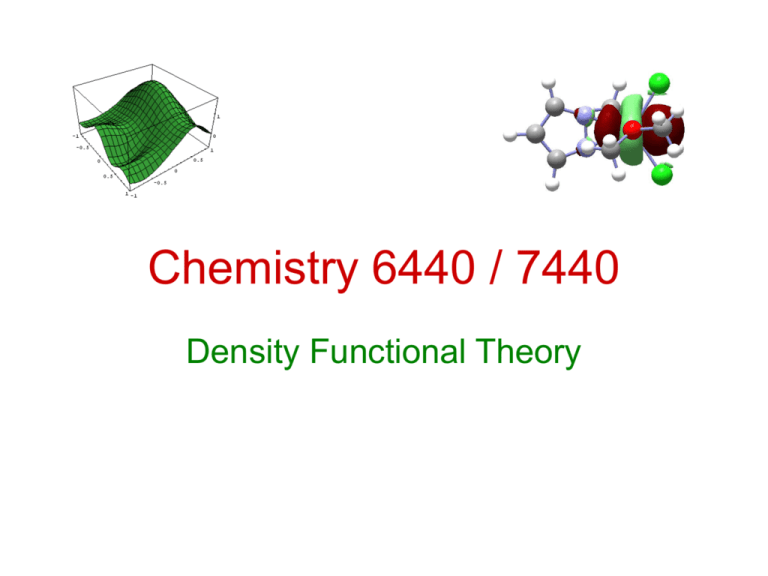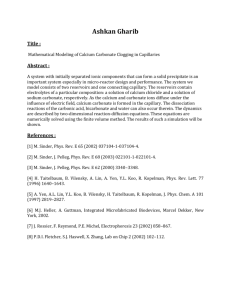Chemistry 6440 / 7440 - Department of Chemistry, Wayne State
advertisement

Chemistry 6440 / 7440 Density Functional Theory Electronic Energy Components • Total electronic energy can be partitioned E = ET + ENE +EJ + EX +EC ET = kinetic energy of the electrons ENE = Coulomb attraction energy between electrons and nuclei EJ = Coulomb repulsion energy between electrons EX = Exchange energy, a correction for the self-repulsions of electrons EC = Correlation energy between the motions of electrons with different spins • ET, ENE, & EJ are largest contributors to E • EX > EC Electron Correlation • In the Hartree-Fock approximation, each electron sees the average density (aka mean field) of all of the other electrons • Two electrons cannot be in the same place at the same time • Electrons must move two avoid each other, i.e. their motion is correlated • Types of electron correlation – Dynamical – Non-dynamical • The difference between the exact energy and the Hartree-Fock energy is the correlation energy for a particular basis set. Resources • Cramer: Chapter 8 & Jensen: Chapter 6 • Scuseria and Staroverov,Theory and Applications of Computational Chemistry The First Forty Years, Chapter 24, 2005. • Kohn Nobel Lecture: Reviews of Modern Physics,71,1253, 1999. • Foresman and Frisch, Exploring Chemistry with Electronic Structure Methods, Appendix A • Burke’s DFT book (work in progress): http://dft.rutgers.edu/kieron/beta/b4.pdf • Parr and Yang, Density Functional Theory, Oxford University Press, 1989. Motivation • The wave function itself is essentially uninterpertable. • Reduce problem size: Wave functions for Nelectron systems contain 4N coordinates. • Wave function based methods quickly become intractable for large systems, even with continued improvement in computing power, due to the coupled motion of the electrons. • A desire to work with some physical observable rather than probability amplitude. Thomas-Fermi-Dirac (TFD) Model • Energy is a function of the one electron density, • Nuclear-electron attraction & electron-electron repulsion (1)(2) ENE [ ] Z A d J[ ] d 1d 2 rA r12 A • Thomas-Fermi approximation for the kinetic energy 3 5/3 T [ ] c d c (3 2 ) 2 / 3 10 • Slater approximation for the exchange energy 1/ 3 9 3 EX [ ] c 4 / 3d c 1 8 X Model • TFD does not predict bonding and the total energies are in error by 15-50 %. • If the value in Slater’s Ex is treated as parameter, then better results are achieved. • The X model (aka Hartree-Fock-Slater) uses = 3/4. • Although X has been superceded by modern functionals, it is still useful for inorganic systems and preliminary calculations. Theoretical Basis • Hohenberg and Kohn (1964) – – – – Energy is a functional of the density E[] The functional is universal, independent of the system The exact density minimizes E[] Applies only to the ground state • Kohn and Sham (1965) – Variational equations for a local functional E[] Ts [] ENE [] J[] T[] Exc [] VNN – can be written as a single Slater determinant of orbitals,but orbitals are not the same as Hartree-Fock – EXC takes care of electron correlation as well as exchange Constructing Density Functionals • Exact form is unknown. Hohenberg-Kohn is only an existence proof. • Density functionals have the form: E[ ] (1 a) E local X bEX aE HF X (1 c) E local C cEC • For LSDA: a = b = c = 0 • For Pure Functionals: a = 0 • Systematic improvement of functionals is possible, but complicated by the fact that exact constraints and properties of said functionals are still being elucidated. Type of Density Functionals • Local spin density functionals (LSDA) – Depend only on the density – Derived for an electron gas, aka “jellium” • Generalized gradient approximation (GGA) – Depends on ||/4/3 • Meta-GGA 2 1 – Depends on (r) i i (r) 2 • Hybrid functionals – Mix some Hartree-Fock exchange (aka exact exchange) Decreasing Computational Costs Increasing Chemical Accuracy Accuracy vs. Computational Cost Exchange, Ex revPBE 1998 G96 mPW Dirac 1930 X 1951 PW86 PW91 xPBE 2004 PKZB 1999 PBE 1996 TPSS 2003 RPBE 1999 B86 LSDA BR89 B88 GGA Meta-GGA Correlation, Ec B88 VWN 1980 B95 xPBE 2004 CA Data 1980 PW92 PW91 PZ81 W38 PBE 1996 PKZB 1999 TPSS 2003 PW86 LYP 1988 CS 1975 LSDA GGA Meta-GGA Calculating Exc Terms • Exchange-correlation functionals must be numerically integrated – not as robust as analytic methods • Energies and gradients are 1-3 times the cost of Hartree-Fock • Frequencies are 2-4 times the cost of HF • Some of this computational cost can be recuperated for pure density functionals by employing the density fitting approximation for the Coulomb interaction. DFT Performance • For accurate energies some exact exchange is needed, although systematically improved functionals such as TPSS do outperform hybrids. • GGA functionals offer a major improvement over LSDA in terms of energetics.The improvement from GGA to Meta-GGA is not as large as that from LSDA to GGA. • Open-shell DFT calculations are less prone to spin contamination. • Multiconfigurational problems and van der Waals interactions are poorly described. DFT Literature • Exchange-correlation hole density, nxc(r,r’) – describes how the presence of an electron at the point r depletes the total density of the other electrons at the point r’. • Linear response function, (r,r’;) – describes the change of total density a the point r due to a perturbing potential at the point r’ with a frequency . • Energy density, X or C – energy density per particle DFT Strategies • As usual, start with minimal or DZ basis sets before attempting very diffuse and polarized ones. • For preliminary calculations or to clean up starting structures, use LSDA rather than HF. This is particularly important for metal containing systems. • Optimize structures with a pure functional to benefit from the density fitting speedup. • Pay attention to the <S2> value and run stability checks when necessary. • If a tighter integration grid is required, optimize with the default grid, then re-optimize with the tighter grid. DFT in Gaussian • The exchange and correlation functional must both be specified. TPSSTPSS • Not all exchange and correlation functionals can be combined. • LSDA functionals: LSDA, SVWN5, XAlpha • Density fitting: BLYP/Basis Set/Auto • SCF problems: SCF=dsymm • Tighter integration grid: Integral(Grid=Ultrafine) • Stability checks: Stable=Opt • • • • • • • • • • • • • • • • • • • • • • • • CA Data - Phys. Rev. Lett., 45, 1980, 566. CS - Theor. Chim. Acta, 37, 1975, 329. Dirac - Proc. Camb. Phil. Soc., 26, 1930, 376. B86 - J. Chem. Phys., 85, 1986, 7184. B88c - J. Chem Phys., 88, 1988, 1053. B88x - Phys. Rev. A., 38, 1988, 3098. B95 - J. Chem. Phys., 104, 1996, 1040. BR89 - Phys. Rev. A., 39, 1989, 3761. G96 - Mol. Phys., 89, 1996, 433. LYP - Phys. Rev. B., 1988, 37, 785. mPW - J. Chem. Phys., 108, 1998, 664. PBE - Phys. Rev. Lett., 77, 1996, 3865. PKZB - Phys. Rev. Lett., 82, 1999, 2544. PW86 - Phys. Rev. B., 33, 1986, 8800. PW91 - Phys. Rev. B., 46, 1992, 6671. PW92 - Phys. Rev. B., 45, 1992, 13244. PZ81 - Phys. Rev. B., 23, 1981, 5048. RPBE - Phys. Rev. B., 59, 1999, 7413. revPBE - Phys. Rev. Lett., 80, 1998, 890. TPSS - Phys. Rev. Lett., 91, 2003, 146401. VWN - Can. J. Phys., 58, 1980, 1200. W38 - Trans. Faraday Soc., 34, 1938, 678. xPBE - J. Chem. Phys., 121, 2004, 4068. X - Phys. Rev., 81, 1951, 385. Density Functional Literature References



